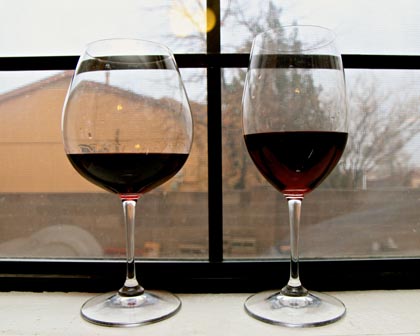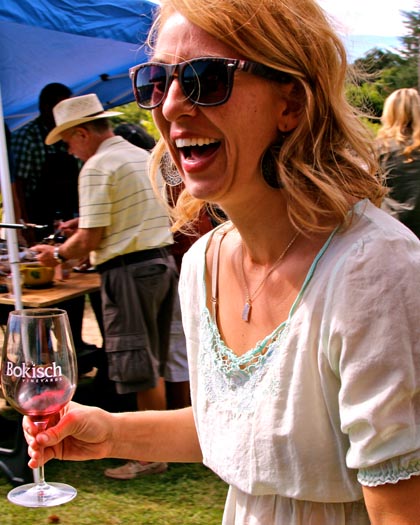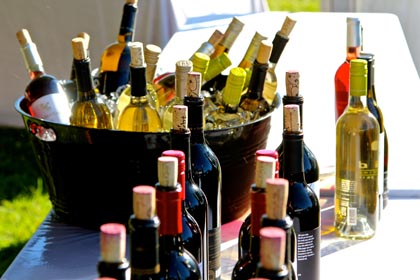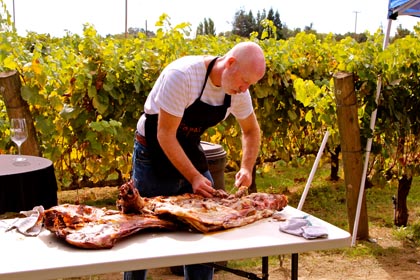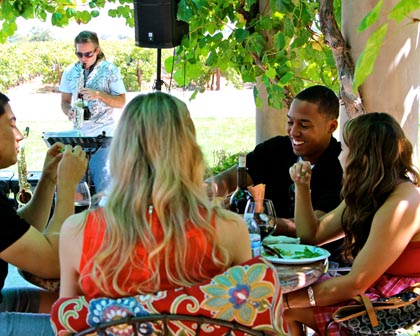Letters from Lodi
An insightful and objective look at viticulture and winemaking from the Lodi
Appellation and the growers and vintners behind these crafts. Told from the
perspective of multi-award winning wine journalist, Randy Caparoso.
Three things that matter (when getting the most out of wine)
Comparison of bowl shaped “Burgundy” glass (on left; ideal for Pinot Noirs) with traditional tulip shaped glass (ideal for white wines and reds wines such as Zinfandel and Cabernet Sauvignon)
GETTING SOME FUN OUT OF WINE
When most of us enjoy our wine, we don't like to think about it too much. We don't need to ooh and ah over the "bouquet," and we don't need to take tiny sips and roll the wine in our mouth for 60 seconds before pronouncing it good.
Ah, but there are still few things that matter when it comes to getting the maximum pleasure from a bottle, whether it is a $10 Sauvignon Blanc, an $18 Zinfandel or a $180 Cabernet Sauvignon.
Because, it is true: you can lessen you enjoyment if everything is not exactly copacetic. If you keep, say, the following three things in mind, you can indeed enjoy your wine much more, without having to think about it at all. Our suggestions:
Lodi wine lover
WINE GLASSES MATTER
Drink you wine from a lousy wine glass, then your wine tastes… okay. But if you drink your wine from a fantastic wine glass, then that same wine can taste more than okay – maybe fantastic.
Therefore, the first order of business is always to invest a tiny bit more for a couple of styles of ideal wine glasses. The best wine glasses come with a stem, are crystal clear for visual pleasure, have fairly thin (as opposed to fat) lips, and are curved inward to allow your nose to better catch the aromas collecting just below the rim.
Why? Because what everyone perceives as "flavor" is actually what you smell. When, for instance, you have a bad cold and can't smell much of anything, then everything you eat or drink tastes the same – not much of anything. Therefore, the more you can smell from a wine glass, the better the wine tastes. In other words: it is always best to drink wine from a wine glass that maximizes aromas and, thus, overall taste.
Size and shape in a wine glass also matter. Generally speaking, white wines taste best in 12 to 14 oz. glasses in an elongated shape of a tulip. Red wines – especially Zinfandels, Merlots and Cabernet Sauvignons – also taste good in a tulip shaped wine glass; but can taste even better if that tulip shape is bigger – holding 18, 19, even up to 24 ounces of wine.
Why do red wines taste even better in larger wine glasses? Because red wines have tannins and other phenolic compounds (such as pigments) that make them denser and heavier than white wines. Thus, they need a larger surface area in a glass to increase the amount of vapors (through swirling) that you perceive as aromas and flavors.
A simple way to test this theory is to do a side-by-side comparison. Taste a red wine in a small, 8 to 12 ounce glass next to the same red wine in a 18 to 24 oz. glass. If you don't have different glasses at home, try it in a nice restaurant where they often have smaller glasses for white wines and larger ones for red wines. Chances are, you'll see the difference: red wine almost always taste better in the larger glass (and white wines in slightly smaller glasses).
For more delicate, fragrant red wines such as Pinot Noirs, many wine lovers prefer the rounder, bowl-like "Burgundy" shaped wine glasses, which are invariably large (usually 18 to 25 ounces). The increased surface area in bowl shaped wine glasses only emphasizes the attractive perfume of Pinot Noir. But for red wines such as a good Lodi Zinfandel, decent sized tulip shaped glasses are probably best, because the elongated shaped of tulips tend to focus the natural berryish qualities of Zinfandel aromas into the nose better than bowl-shaped glasses.
But again, this is not to over-think things. But when you start with an ideal wine glass, wine simply tastes better.
TEMPERATURES MATTER
Why serve wine at "proper" temperatures? As with wine glass shapes, it only makes a wine taste better. Or, think of it this way: you get more for your money.
White, pink and sparkling wines are traditionally served chilled (38 to 40 degrees Fahrenheit), and red wines taste best at "room temperature." But keep in mind that ideal room temperatures for wines are not the same as for human beings; ideally, it is between 65 and 72 degrees — significantly cooler than a typical summer day.
Be as it may, most red wines are not at their best served super-chilled like white wines because their higher tannin and weight lock in aroma and flavor if served at icy temperatures.
White, pink, and sparkling wines, of course, are simply more refreshing served well chilled; whether soaked in icy water for 20 minutes or chilled for two hours in a refrigerator. Cooler temperatures tend to accentuate aromas and flavors of fruit, which is what white and pink wines are all about.
Softer, fruit driven red wines, such as Beaujolais from France, as well as many Pinot Noirs and lighter Zinfandels and Tempranillos, are probably best enjoyed at around 60 degrees. To get that temperature, all you need do is stick your bottle in the refrigerator for about 45 minutes.
Heavier red wines with more tannin – such as Cabernet Sauvignons and more serious Merlots, Syrahs, Petite Sirahs and red Zinfandels – don't need quite as much chill: more like 65 degrees (or just 30 minutes in a refrigerator).
But one thing you never want to do is serve yourself a heavy red wines that is too warm (80 degrees or higher). "Hot" temperatures tend to accentuate a big red's alcohol and tannin, making the wine taste coarse or rough, and detracting from the natural fruit qualities and complexities winemakers work so hard to produce.
Wood roast in Lodi’s Bokisch Vineyards
FOOD MATTERS
Let's not make things too complicated. Yes, it is possible to break things down and talk extensively about "ideal" wine and food matches (re one of our previous posts, The science behind common sense wine and food combinations).
Suffice to say, food matters because it always winds up in the same place as your wine: in your mouth. No matter how you slice it, a light, lemony tart, dry white wine always tastes better with a filet of fish or a bowl of clams or shrimp than a heavy-duty red wine. And a heavy-duty red wine will always taste better with a charred filet of beef or fatty chunk of lamb than a light, lemony tart white wine.
It is simply a matter of what sensations taste better when put together. A lemony tart white wine tastes great with white fish or oysters in the same way that a squeeze of lemon makes fish and oysters taste better. A big, strong Cabernet Sauvignon or generous Zinfandel makes a steak taste great in the same way that charring on a grill or slathering in a rich sauce makes a steak taste better.
You should never feel dictated by "rules" of wine and food matching. But certain things only make sense; especially if you simply wish to get the maximum enjoyment out of your wine. Think about that?
Enjoy your holidays!
Wine lovers at Lodi’s Van Ruiten Family Winery
